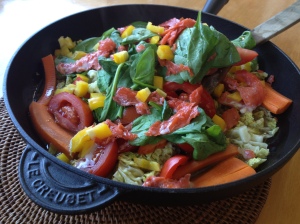My ‘French Kids’ School Lunch Project’ is back by popular demand! (For a full explanation of how school lunches are organized in France, click here.)
This week we’re in Mouans Sartoux, a small town in the Southern Alps in Provence. It’s the first French town of more than 10,000 people to decide to provide 100% organic meals to children at school. Remember: there are no national subsidies for school lunches in France. Communities organize and pay for the meals locally; parents pay a reasonable price per meal (usually on a sliding scale according to the family’s income, subsidized by municipal taxes if necessary). This is a great example what can happen when communities decide that good food for kids is a top priority.
 The decision to go organic is usually associated with a policy of buying locally. This means that menus which are 100% organic often have less variety than menus in other schools in France. That’s the case here - seasonal vegetables reappear in various formats (fresh salad, cooked salad, puree), which wouldn’t usually be the case. Luckily, there’s lots to choose from at this time of year. Vegetables include eggplant, tomato, zucchini, and onions (to make the wonderful southern French stew called ‘Ratatouille’). Veggie sautees are also popular (like this one I made last night for our family). I can’t even begin to list all of the fruits-but the grape harvest is just happening, so sweet grapes will probably be found on every table.
The decision to go organic is usually associated with a policy of buying locally. This means that menus which are 100% organic often have less variety than menus in other schools in France. That’s the case here - seasonal vegetables reappear in various formats (fresh salad, cooked salad, puree), which wouldn’t usually be the case. Luckily, there’s lots to choose from at this time of year. Vegetables include eggplant, tomato, zucchini, and onions (to make the wonderful southern French stew called ‘Ratatouille’). Veggie sautees are also popular (like this one I made last night for our family). I can’t even begin to list all of the fruits-but the grape harvest is just happening, so sweet grapes will probably be found on every table.
Should all schools go organic? The French government thinks so: it has mandated a target of 20% organic for school lunches (a target that not many schools have met, at least not yet). It’s a debate that French parents and teachers are still having — some would prefer cheaper food and more variety (even if the food isn’t organic and local). But as the transition to organic school food happens in more places, variety should be easier to find-as more local producers go organic. And prices might even drop. But they’ll remain higher than for conventional food. So most communities who have gone organic have also decided to subsidize kids’ meal from the municipal tax budget. This doesn’t tend to raise much protest in France — because people truly believe that food-and teaching children how to eat well-is one of our most important collective responsibilities. Food for thought!
As usual, the meals follow a four course structure: vegetable starter; main dish with vegetable side; cheese course; dessert. All meals are served with fresh baguette (eaten plain, usually one piece per child!) and water. No flavoured milk, juice, sports drinks, or pop. No vending machines. No fast food or junk food. Food for thought!
Monday, September 24th
Salad: Tabouleh salad
Main and Cheese/Dairy combined: Cheese omelette with seasonal vegetables
Dessert: Seasonal fresh fruit
Tuesday, September 25th
Salad: Seasonal fresh vegetable salad
Main: Beef casserole with pureed seasonal vegetables
Cheese/Dairy: Cheese
Dessert: Fruit cake
Wednesday, September 26th
Salad: Seasonal fresh vegetable salad
Main: Hake filet with bulghur and tomato sauce
Cheese/Dairy: Cheese
Dessert: Fruit compote
Thursday, September 27th
Salad: Potato salad
Main: Chicken wings, sauteed seasonal vegetables
Cheese/Dairy: Cheese
Dessert: Seasonal fruit
Friday, September 28th
Salad:
Main: Grilled pork with pasta and ‘napolitano’ sauce
Cheese/Dairy: Yogurt
Dessert: None
Bon Appétit!
This blog post is part of my French Kids School Lunch Project. Every week, I post the school lunch menus from a different village or town in France, where three-course, freshly-prepared hot lunches are provided to over 6 million children in the public school system every day. These meals cost, on average, $3 per child per day (and prices for low-income families are subsidised). My hope is that these menus (together with my other blog posts about the French approach to kid’s food) will spark a conversation about what children CAN eat, and how we can do better at educating them to eat well.

A Mother at school informed me last week that “hot dogs and tater tots” were on the menu. Really? How on earth does that meet nutritional standards? I would eat ALL of the menu above, and probably feel fantastic all day. Keep up the good news!
LikeLike